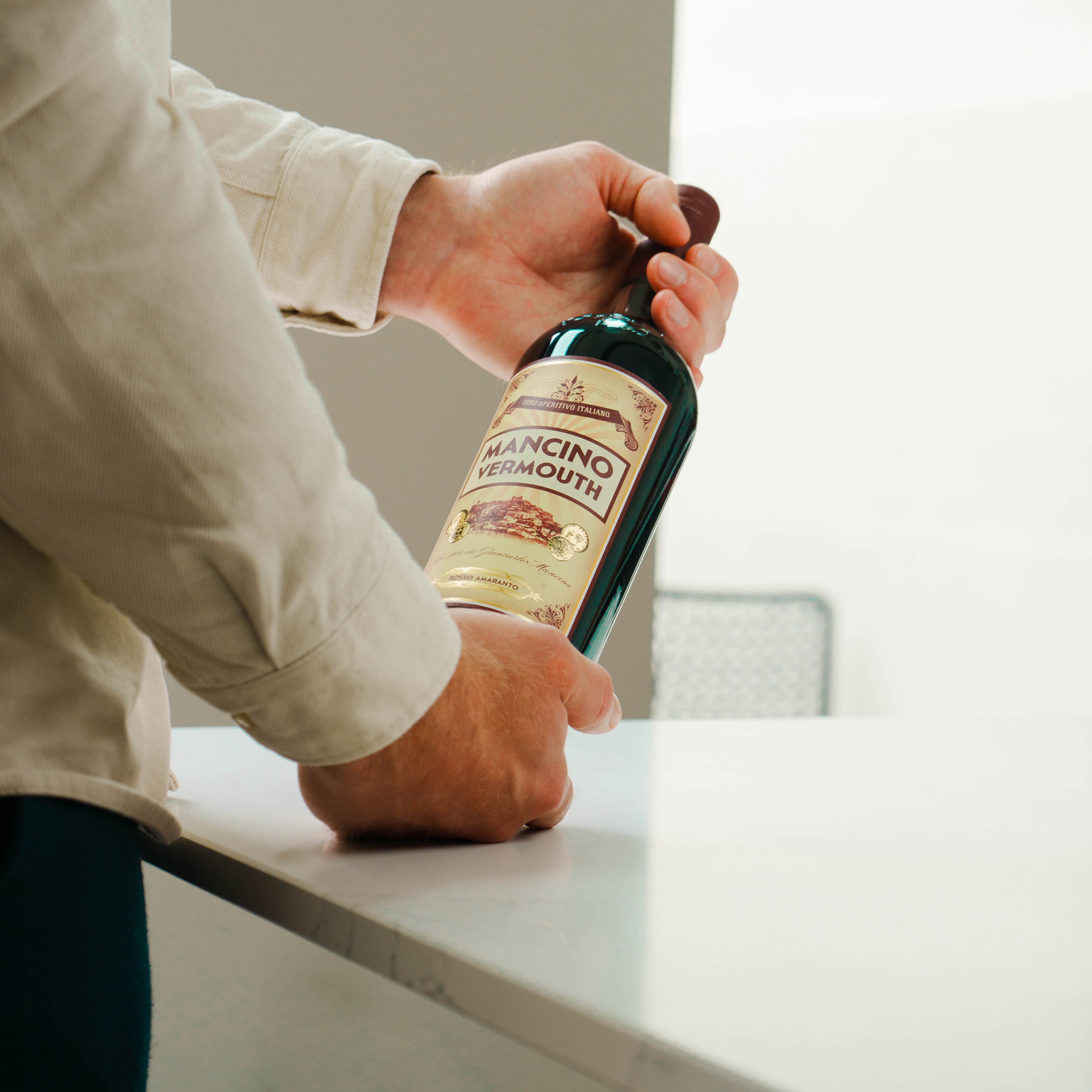Navigating Vermouth - a guide to understanding wine based aperitifs
Posted by Spirits Kiosk on 7 Aug 2023
Whether you're a novice to this versatile fortified wine or a seasoned enthusiast seeking to broaden your understanding, this deep dive will provide valuable insights. Here, we will illuminate the essentials of what vermouth is, the intricate processes involved in its production, and how to properly store it for optimum flavour preservation.
Additionally, for those eager to experience vermouth's multi-layered taste profile, we offer expert suggestions on which eminent brands to sample first.

What is vermouth?
Vermouth is a type of fortified wine that has been aromatised with various botanicals, including roots, barks, flowers, seeds, herbs, and spices. The name "vermouth" comes from the German word "Wermut," which means wormwood, a key ingredient in the drink and one of the primary botanicals used.
Vermouth originated in Europe, with Italy and France soon becoming the most renowned producing countries.
The drink comes in two main styles: sweet (also called red or rosso) and dry. Sweet vermouth, often red in colour, is sweeter and more aromatic, while dry vermouth, typically straw like yellow tinted in colour, is less sweet and is often used in cocktails like a Martini.
It's important to note that although vermouth is fortified, it's less alcoholic than spirits, with an alcohol by volume (ABV) usually ranging between 15% and 18%. Vermouth is enjoyed in a variety of ways: as an aperitif, in cocktails, or even used for cooking.
The exact recipe and method for making vermouth are often closely guarded secrets of the producers, but it invariably involves infusing a base wine with a blend of botanicals, adding a spirit to fortify it, and often sweetening, particularly in the case of sweet vermouth. The resulting mix is complex, aromatic, and flavourful, making it a staple in many a bartender's toolkit and an essential for the Aperitivo hour.

How is vermouth made?
Choosing the right wine is critical in the production of Vermouth, as it constitutes around 75% of the content. It’s the single biggest decision producers make when creating their expressions.
Historically Moscato wine sourced from the Piedmont region of Italy, has been the predominant variety used due to its high sugar content, which offers an ideal mouthfeel and reduces the amount of sugar required to be added later. Prominent brands like Cocchi di Torino and Carpano Antica Formula still use Moscato today.
As the demand for Moscato wine surged in the 20th century, vermouth producers started sourcing their grapes from other regions like Sicily and Sardinia. The Catarratto grape, known for its low acidity, high sugar content and flavours of citrus, sweet spice and herbs, soon became widely used for vermouth production.
The selection of grape varieties further expanded with time, including less aromatic wines like Cortese and Trebbiano, which offer a blank canvas for producers to work with while maintaining the desirable mouthfeel of a vermouth.
Spanish producers tend to use Macabeo, a grape that can vary from fresh and floral to honeyed and nutty, like Moscato. There's also a recent trend of using red grapes like Tempranillo and Garnacha, and Alberino from Galicia. Moreover, the tradition of making Vermouth with sherry is still alive in regions like Jerez.
In the UK and other countries, including America, Australia, and Germany, various wine types like reds, rosé, and orange wines, and grape varieties such as Riesling, Gewürztraminer and Viognier, are gaining popularity for their rich, fruity, and aromatic nature.
The trend can be seen in brands like Regal Rogue, which proudly uses 100% organic Australian wines, each showcasing a different grape variety.
Once you move beyond the wine base, fortification needs to be understood.

By adding a touch of spirit, the wine raises in ABV and other flavours can be added (through the likes of distilled botanical distillates). The spirit used to fortify wine needs to be of agricultural origin to meet the stringent EU rules. Traditional choices include Brandy or Grappa, but Neutral Grape Spirit is now more commonly used. The use of fruit brandy has not disappeared altogether either; with brands like Belsazar using fruit brandies to create a unique fruity vermouth with devilishly complex profiles.
The sweetness in vermouth comes primarily from the wine's natural sugars, sometimes enhanced with natural sugars, honey, or syrup. Some producers use caramel for colour, sweetness and aroma, while others use Mistelle, a sweetener made from grape juice or grape must. Getting the dosage just right is a big part of perfecting a recipe.
Botanicals are the final significant part of vermouth production, particularly Artemisia, which is a requirement of all vermouth. The two commonly used species are Grand Wormwood and Roman Wormwood. Different producers use unique extraction methods, including maceration and distillation, to infuse the botanical flavours into their vermouths.
As you can see, there are many facets that producers need to consider. Producing good vermouth requires attention to the quality of the wine base, the selection of botanicals, and the extraction and fortification methods used. The combination of these decisions cumulate to the end flavour and quality of each expression.
And that's not all either - there's the stylistic, entirely subjective parts to now layer on. For example, whether a vermouth should reflect the terroir of its grape and how it embodies the brand's unique identity.
It's a heady mix of winemaking knowhow, botanical knowledge, the art of distilling and honing a brand all in one place!

How to store vermouth at home
Vermouth should be stored in the refrigerator once it's been opened. The reason for this is that vermouth is a fortified wine, which means that while it has a longer shelf life than regular wine, but it can still oxidise and degrade over time, especially when exposed to heat and light. This process can alter the flavours and aromas, making the vermouth taste "off" or stale.
Storing opened vermouth in the fridge slows down the oxidation process. It's recommended to consume it within 2 to 3 weeks, although it can last up to 3 months in our experience. If you notice a change in smell or taste, it may be best to drink up and replenish your supplies.
Also, it's advisable to store vermouth bottles upright, which minimizes the surface area exposed to the air and thus slows the oxidation. Using vacuum wine stoppers can further extend the life of opened vermouth by removing air in the bottle.
In terms of unopened bottles, they can be stored in a cool, dark place like a wine cellar, cabinet, or pantry. You should avoid places with temperature fluctuations, such as near an oven or on top of a refrigerator. This helps to maintain the quality and taste of the vermouth until you're ready to open it.
Remember, no matter how well you store your vermouth, it won't last indefinitely. It's best to enjoy this aromatic, complex drink while it's fresh!

A few vermouth brands to start your journey
If you're looking to explore the world of sweet vermouth, some of the most celebrated names are certainly worth a try.
Start with Martini Rosso, one of the most recognised and globally available brands, offering a balanced, semi-sweet flavour profile, making it a versatile choice for numerous cocktails. Once you know what the centre ground of the category, explore sideways from there. Carpano Antica Formula, from the house that purportedly created the first vermouth, is a beautifully rich and complex option. Its vanilla and bitter cocoa notes make it a delightful sipping vermouth.
Cinzano Rosso, with its lush and vibrant herbal-citrus blend, is an excellent and affordable staple, ideal for adding depth to any cocktail. Finally, Cocchi Vermouth di Torino, crafted in the traditional Piedmontese style, is renowned for its robust flavour, marked by intense notes of Moscato wine, citrus, and spices.
Any of these famous names are sure to elevate your vermouth experience.


